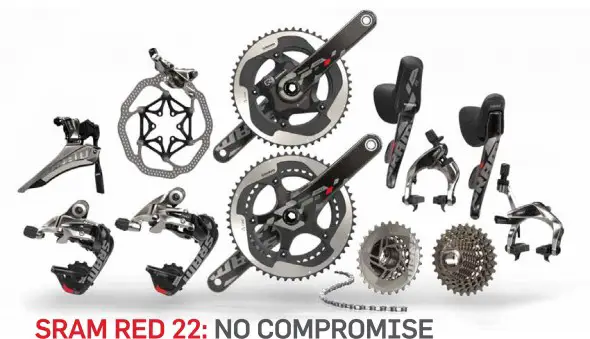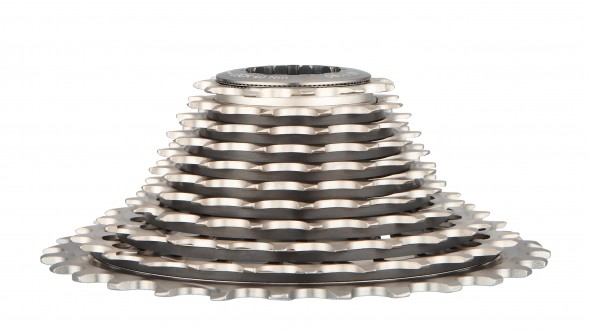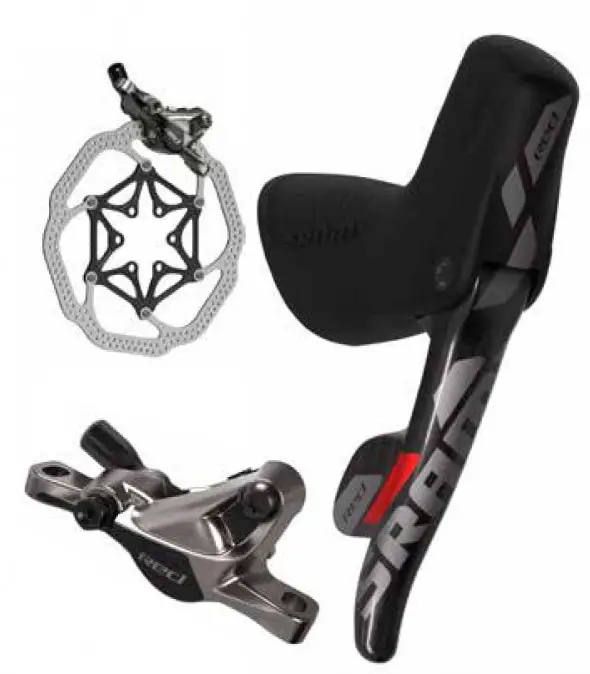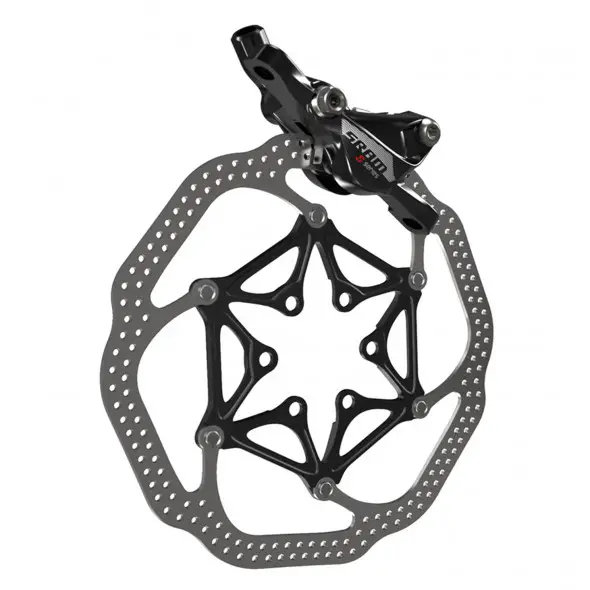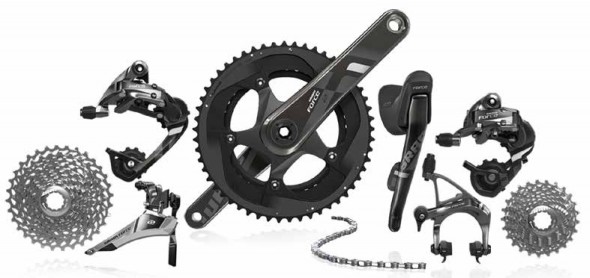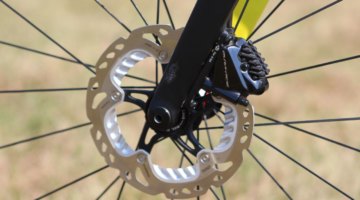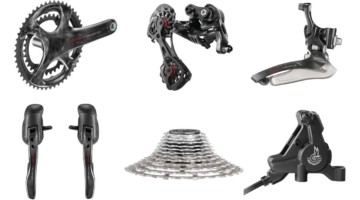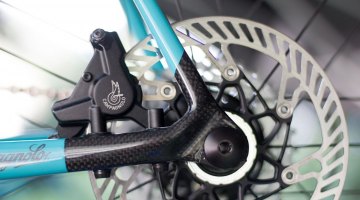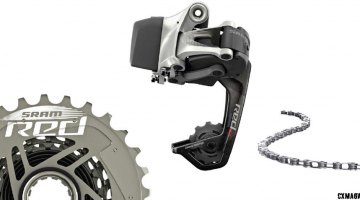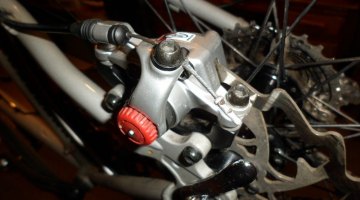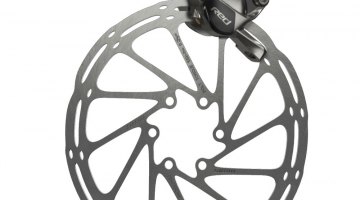It’s the week of cyclocross and road hydraulic disc brake launches. Today SRAM unveiled their new offerings, and on Tuesday, we’ll get the first official test ride on TRP’s HY-RD hybrid hydraulic/mechanical disc brake (as well as their dual-piston Spyre mechanical disc brake.
One of the worst-kept secrets in cyclocross tech, thanks to some embargo violations and a telling “April Fool’s Day” video, was unveiled by SRAM today. The Chicago-based company officially unveiled their model year 2014 offerings, including an 11-speed cassette available for both their Red and Force components, and hydraulic disc brakes. Stay tuned as we test these components at Sea Otter 2013.
Adding Another Rear Cog
With the slogan, “Twenty-two isn’t just our cool new logo; it means you get use of every gear in any combination. True 22,” it’s clear that SRAM has followed Shimano and Campagnolo in adding an 11-speed to their ’cross collection. While they already have an 11-speed cassette for mountain bikes, this is the first of its kind for road/cyclocross.
The SRAM Red 22 has few differences from the 2012 version, reviewed by Cyclocross Magazine here, but the company says it didn’t need much: “Adding two more gears to that combination was arguably the only improvement required. The added benefit is that now, without adding weight, we maintain a system that shifts incredibly fast upfront, and with the best and smoothest gear transitions in back. And, for the first time available anywhere for the majority of standard road frames, the system gives you twenty-two gears.”
As for the Force 22, “Apart from the complete overhaul, SRAM Force also provides you twenty-two usable gears, Yaw™ shifting speed and precision that can only be matched by SRAM Red, and a new sleek finish,” SRAM stated. “The understated SRAM Force gruppo is … our most exciting introduction for 2013, and we designed it to be everything any rider at any level would ever require, and it’s ready for your best.” There will also be a smaller crankset option, down to 165mm, which is good news for shorter racers.
Going to Hydraulic Discs
And then, there are the new hydraulic disc brakes, which many cyclocrossers probably care more about than an extra cassette cog. Racers paying close attention to the pros last season may have noticed Tim Johnson piloting the SRAM hydraulic prototypes at a few races, and they’re finally here. As for the hydraulic brakes, SRAM issued the following statement: “SRAM, long a leader in hydraulic braking technology with our Avid brand, has reset the vision for road bike braking for the coming decade. Not unlike every other high speed conveyance, SRAM brings hydraulic technology to road cycling for multiple applications. Disc or rim brake, SRAM will stop what you’ve propelled, faster and with better modulation.”
Riding on hydraulic brakes for cyclocross is nothing new for the Cyclocross Magazine staff, as two years ago we got first rides on TRP’s Parabox hydraulic disc brake system and 324 Labs’ Formula R1-based brake adapter two years ago. You may have already seen hydraulic brakes win cyclocross races, with TRP’s Parabox adapter in action on Ben Berden’s bikes, or on 45-49 Masters World Champion Don Myrah, who rides 324 Labs’ system.
SRAM will offer two different hydraulic brakes: the Red hydraulic disc brake and the slightly heavier S700 disc brake (see below for full specs) that is accompanied by an aluminum s700 lever, set up for 10-speed only.
Should You Rush to Upgrade?
So, what does this mean for cyclocross? With 11-speeds, the new groupo can provide more versatility, with more options for wider range of gears, or a smaller jump between a few cogs. The risk, of course, is potential mud clearance with the cassette: some ’crossers still refuse to upgrade to 10-speed because of the amount of organic material that can get stuck between the narrower cogs on the cassette. And, naturally, the cost alone is enough to give racers pause in making the upgrade decision just for an extra gear, but the hydraulic brakes may be a big draw to move to the 2014 SRAM Red Double Tap levers. We’re sure plenty of sponsored racers will be sporting the SRAM Red 22 this coming season, and we’ll be excited to see how it works.
On the hydraulic side of things, riders can look forward to more powerful, lighter action braking with self-centering pads, allowing for less rubbing on one side even in muddy conditions. Also, because conventional brake cables and steel housing are heavier than most hydraulic brake lines, racers can also look forward to a potential weight reduction in their braking systems.
The downsides? The potential (in longer races, like gravel grinders, or rides with long dirt or road descents) for the system to overheat and lead to brake failure, leaving you with nothing but a shoe to jam in the wheel, BMX-style. In particular, this potentially affects people who are swapping out parts for weight-savings, since thinner rotors are more inclined to overheat. Lastly, there may be a steep learning curve for roadies who don’t use hydraulics: pulling the brake lever while the wheel isn’t on the bike can result in a jammed brake pad that needs to be pried apart, something a roadie may not be prepared for.
Lastly, a hydraulic brake left unattended (i.e in a garage for months post-season) may need its system bled: these brakes need more maintenance, and a lack of attention to maintenance can be more catastrophic for racers than with standard cantilever or mechanical disc brakes.
Many of us mix SRAM and Shimano cassettes without problem, but we’re curious to see if that will still be possible with the new SRAM Force and Red.
Also rumored to be in the works are new Avid drop bar mechanical and hydraulic disc brake options to complement the new Avid BB7 Road SL mechanical disc brake (reviewed in Issue 20 of Cyclocross Magazine). New brakes to come are two other BB7 models, called BB7S, and two new hydraulic disc brake options for the road/’cross set (hence the DB for drop bar), the DB1 and DB3.
We’ll have more details, impressions and photos at Sea Otter later this week. Can’t wait? Check out our review of SRAM Red from 2012.
SRAM Red 22:
Completely rebuilt and redesigned throughout
11-speed Yaw™ front derailleur – no trim, rub , or rasp – with chainspotter – and even lighter
Hydraulic brake options: Hydraulic Road Rim braking (HRR) & Hydraulic Road Disc braking (HRD)
- MSRP: $2618
- Available July 2013
SRAM Force 22:
- New component: Shift/Brake Lever, Rear Derailleur, Front Derailleur, Crankset, Cassette and Chain
- 11-speed YAW™ front derailleur: no trim, rub, or rasp – with chain spotter – and even lighter
- PG-1170 cassette: seamless shifting now with a 16T
- MSRP: $1358
- Available July 2013
Hydraulic Brakes:
- SRAM RED 22 Hydraulic Master Cylinder & Shifter:
All new master cylinder specifically designed for road applications.
New RED 22 shifter design and ergonomics including reach adjust.
Lower hand forces required.
Standard & Moto options available.
Fully sealed system.
Easy bleed access. - SRAM RED Hydraulic Disc Brake Calipers:
Optimized power & modulation for road/’cross.
19mm front/18mm rear pistons.
Lower hand forces required.
Road specific caliper and piston ratio.
Fully sealed system.
Disconnect Banjo Option (OEM option).
HSX Rotors sold separately.
160mm for pavement, 140mm option for off-road.
449 grams per wheel (Lever, Caliper, Hose and 160mm HSX rotors). - SRAM S-700 Hydraulic Disc Brake
10 Speed Compatible Only.
Aluminum Shift and Brake levers.
Steel-backed pads.
Stainless hardware.
HS1 rotors sold separately.
160mm for pavement; 140mm option for off-road.
493 grams per wheel (Lever, Caliper, Hose and 160mm HS1 rotor) - MSRPs
SRAM RED Hydraulic Dics brakes: $1,122 (For the pair. Includes Shift/Brake hydraulic levers, hoses and calipers)
SRAM HSX Rotor: $72 (Single – 160 or 140mm)
Spacers: $20 (set)
SRAM RED Hydraulic brakes: $968 (For the pair. Includes Shift/Brake hydraulic levers, hoses and calipers)
SRAM S-700 Hydraulic Disc brakes: $796 (For the pair. Includes Shift/Brake hydraulic levers, hoses and calipers)
SRAM HS1 Rotor: $57 (Single – 160 or 140mm)
SRAM S-700 Hydraulic brakes: $572 (For the pair. Includes Shift/Brake hydraulic levers, hose and calipers)
Spacers: $20 (set)













